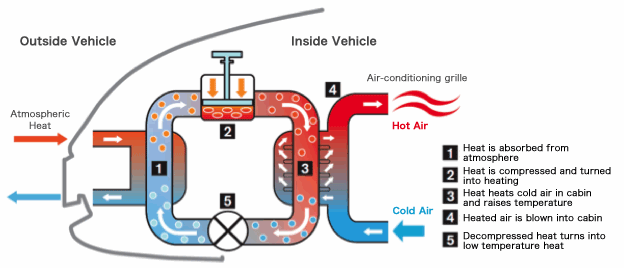Why no heat pump?
Dr. HVAC or How I Learned to Stop Worrying About Not Having A Heat Pump
So I tried to use my shiny new GDS2 tool (the same diagnostics tool that GM mechanics use) to look at what the car reports for HVAC power usage. There’s a TON of data in here, including a lot about power usage.
Unfortunately, it looks like the A/C power details are completely incorrect in the GDS2 tool. I don’t know what data it’s pulling, but it doesn’t seem to be pulling the correct data. Power usage for the A/C floats between 0.4 and 1.1kW pretty much any time the HVAC system is on, even if it’s on full blast heat. A different A/C power usage metric shows up to 7.2kW used by A/C – when heater is on full blast… so, yeah, those numbers aren’t reliable.
So, I took a look a different way. The main HV battery current usage seems reliable, and flips between 0.3A and 0.6A (it only has 0.3A increments), meaning that idle power draw is somewhere around 100-250W when the car is idle. Note that there would be at least some 12V battery charging with this as the car had not been turned on for a day. This is the same metric that you can pull via OBD2, however in this tool it updates live so that you can see it more accurately.
With the heater cranked full power “HI”, I can see 22A maximum at 370V and, while still at maximum, it settles down to about 18.6A after a minute. That’s 6600-8000W taking out the idle power – right around where we expect it since the maximum heater power reports as 7500W. The *average* draw will vary significantly, but is usually in the 2000-3500W range depending on how cold it is outside and how warm you want it inside.
Now using the A/C at full blast “LO”, it will only go up to 2.4A peak, and settles in at 2.1A. That’s 750W. I couldn’t get it to go any higher than that, and it was getting cold quickly in the cabin. Having said that, even turning up the temperature a little only dropped it to 1.5A. I’d have to do this again during the summer to figure out what the average power draw would be, but I’d hazard it probably won’t vary that much. Let’s call it 500W average.
So, this answers a couple questions – first, the A/C takes 1/10th the power as the heater at full blast, and around 1/4th to 1/7th the power as heat for normal usage.
However, that doesn’t mean that having a heat pump would only cost 1/4 to 1/7th the power…
The second answer is – putting in a heat pump instead of a resistive heater means that it would require a much larger unit.
A heat pump is generally about “300% efficient” – meaning that it could put out 2250W of heat at a cost of 750W. However, this is only in good conditions – meaning only about a 10C/18F temperature rise. It gets exponentially worse as you need more heat. Considering that your heater needs to work when it’s cold, a 20C/36F delta drops that to 150% efficient, and a 30C/54F delta drops that to 100% efficient – in other words, it could only put out 750W of heat at a cost of 750W.
So there’s the crux – the time that you want it the most, it’s useless. When it’s 0F outside and we are upset with losing 30-40% of our range, at the time when we need the most range savings, a heat pump is an expensive paperweight, and won’t save us anything.
This data is backed up even by manufacturer claims – According to Bosch, a heat pump drawing 1kW will generate the heat equivalent of between 2-3kW – but looking at their data sheets also shows about a 60F maximum heat delta.
Since we know that, at minimum, we’d want at least 3500W of heat available, we’d need a heat pump unit 3-4x the size as our air conditioner, or we’d need one 2-3x the size plus still have a resistive heater.
This would definitely increase the cost – Nissan charged $1400 USD for this option (and still needed to have a resistive heater too), and doesn’t heat up as quickly as the Bolt. During mildly cold weather you really only save half of the heating energy needed (1-2kW), and during really cold weather you don’t save anything. Since the Leaf had half the range as the Bolt, that’s double the impact.
Considering how Big the Bolt battery is, It’s not hard to see why GM just decided that it wasn’t worth making it an option.


As a former Kia Soul EV (1st gen) owner, I’m not upset that my Bolt and my Kona don’t have a heat pump. On most cold mornings, especially near or below freezing, it would have to run the resistive heater anyway. The heat pump might have run when the car was already warmed up, but it took it most of my commute to warm up.
This is a great analysis. They do make heat pumps that are more efficient in colder temps for homes, but I don’t know if those would fit well in cars. Considering you’re hauling the weight of the heat pump around all year long I could definitely see it’s net effect on efficiency being negative for a car (though it would replace the AC so maybe not that bad). They work great for houses though 🙂
https://profitgreenly.com/heat-pump-roi/
i would really love infraRed emmiting surface to heat myself , and also resistive element in the heater ducking that would generate heat instantly like a air dryer ! i also think heat pump would just increase Bolt price and futur maintenance fees ? Nissan Leaf heat pump repair cost is really bad !